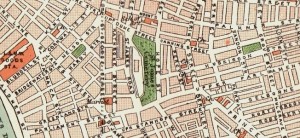St. James Cemetery – a typographic tour
Liverpool Landscapes was a blog charting new discoveries, news and developments affecting Liverpool's historic environment. It was regularly updated between 2007 and 2016.
Liverpool Landscape has now been retired, and most of the less time-dependent articles moved to Historic Liverpool.

Just a quick post today, as the interesting stuff in this case is over on another blog, that of the Liverpool-based company Banana Milk Design. A recent post consists of a tour of St. James’ Cemetery around the Anglican Cathedral, looking at the typography which can be seen.
Typography? Landscape-related?
Well, as the post demonstrates, typography – the selection and use of different fonts around the park – reveals a lot about the motives and methods of the writers/engravers/printers who created the space. (The book Letterpool from a couple of years back shows a great selection of fonts and signs around the city, and the importance of this.)
The post is a picture essay, and an archaeology of gravestones, engraving and the detail to be gleaned from font, material, and quality. There are also reflections on the re-use of gravestones in a walkway, and the nature of graffiti (some of it dating back to before the park was laid out).
Design in History
One of the characteristics of the post is that this is the view of a designer, who sees things archaeologists wouldn’t necessarily see: were the fonts used modern at the time, or already old? what does the font and form of a grave or tomb tell us about the people interred? For example, there is the family tomb of the Rathbones, of which the writer says: “I feel that it has a very noble facade, as if they were a family of importance”. Indeed they were.
This is a great tour of an important historical monument through the eyes of a designer, whose trained eye shows us that typography has been an important indicator of wealth, taste and intent for a long time, and an awareness of the main aspects of the topic can help peel back further layers of history.
Further Reading
For an easy to read over view of the use of fonts throughout history, have a look at Just My Type by Simon Garfield. It’s a guide to the changing fashions of font use across the centuries, and how it was affected by the technology available as well as the message the text was trying to convey.




